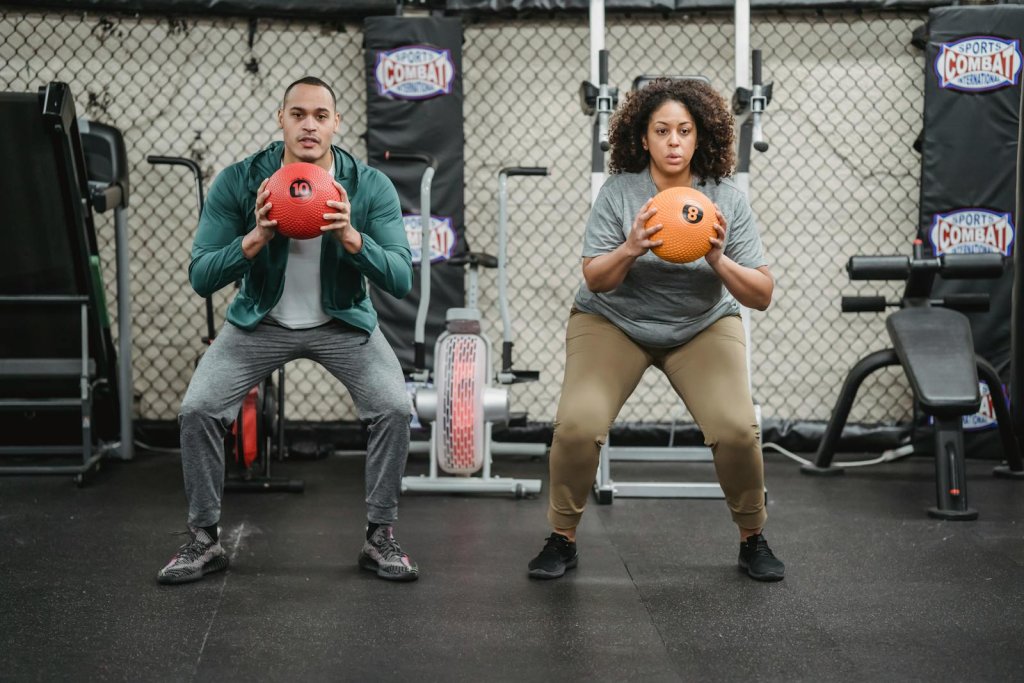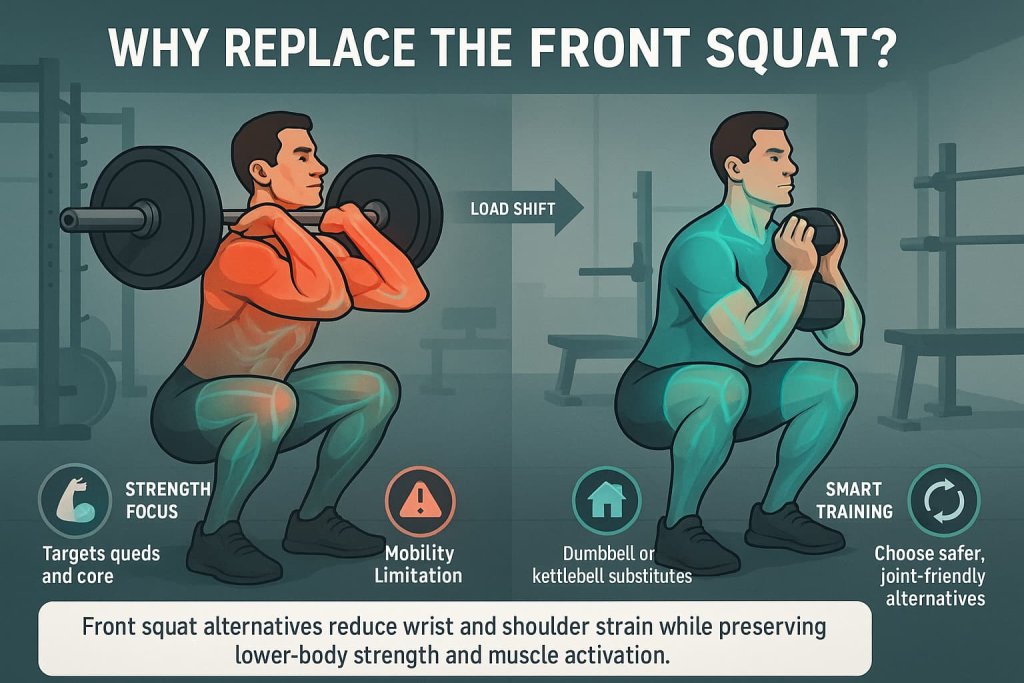The best front squat alternatives help you build powerful legs and core strength — without the shoulder or wrist discomfort of traditional front squats.
If you struggle with mobility, joint pain, or simply want variation in your lower-body routine, there are many effective substitutes that mimic the front squat’s benefits for your quads, glutes, and core.

Understanding these alternatives ensures you keep progressing in strength and hypertrophy while protecting your joints and maintaining training consistency. Below, you’ll find the 13 best front squat alternatives — all backed by sports science and strength-training experts.
Why Replace the Front Squat?
The front squat is an excellent strength builder, but not everyone can maintain proper wrist or shoulder positioning due to mobility limitations. It also places high demand on the thoracic spine and core stabilization.

Common reasons to look for alternatives include:
- Shoulder or wrist pain from front rack position
- Limited mobility or previous injuries
- Home workouts without barbells
- Desire for more variation in quad-focused leg training
Research from the Journal of Strength & Conditioning Research shows that load placement (front vs. back) changes spinal and knee mechanics but not overall muscle activation — meaning you can achieve the same strength gains with safer alternatives.
13 Best Front Squat Alternatives
Below are the top exercises that replicate front squat benefits without shoulder strain. Each strengthens the lower body while maintaining upright posture and core engagement.
1. Goblet Squat
Why it works:
The goblet squat is one of the most beginner-friendly and effective front squat alternatives. Holding the weight at your chest encourages an upright torso, engaging your quads and core while minimizing shoulder or wrist stress. It also teaches proper squat depth and balance.
Muscles worked: Quads, glutes, hamstrings, core.
How to do it:
- Hold a dumbbell or kettlebell at chest level, close to your body.
- Stand with feet shoulder-width apart and keep your elbows pointed down.
- Inhale and lower into a squat, keeping your chest tall and heels grounded.
- Drive through your heels to return to standing.
Trainer Tip:
Keep your knees aligned with your toes. Pause briefly at the bottom to enhance quad activation.
2. Safety Bar Squat
Why it works:
The safety bar squat keeps the load slightly forward—similar to the front squat—while drastically reducing shoulder strain. It’s ideal for lifters with limited shoulder mobility or discomfort from the front rack position.
Muscles worked: Quads, glutes, hamstrings, spinal erectors.
How to do it:
- Position the safety squat bar across your upper traps, gripping the handles in front of you.
- Brace your core and descend slowly until thighs are parallel to the floor.
- Drive up through your heels, keeping your torso upright.
Trainer Tip:
Avoid collapsing forward — think about pushing your chest “up and back” throughout the lift.
3. Zercher Squat
Why it works:
The Zercher squat simulates a front-loaded movement by placing the bar in the crook of your elbows, which heavily engages the core while sparing the shoulders and wrists.
Muscles worked: Quads, glutes, core, upper back, biceps.
How to do it:
- Rest the barbell in the bend of your elbows, holding it close to your torso.
- Squat down with control, keeping your elbows close to your body.
- Drive back up by pushing through your heels and tightening your core.
Trainer Tip:
Use a towel or pad on the bar for comfort. Maintain a tall chest to prevent rounding your spine.
4. Bulgarian Split Squat
Why it works:
This unilateral powerhouse isolates one leg at a time, improving balance, mobility, and lower-body symmetry. It’s also easier on the spine and wrists compared to front squats.
Muscles worked: Quads, glutes, hamstrings, core.
How to do it:
- Place your back foot on a bench behind you.
- Step your front foot forward and lower your back knee toward the ground.
- Push through your front heel to return to standing.
Trainer Tip:
Maintain a slight forward torso lean to better target your glutes and reduce knee strain.
5. Hack Squat (Machine or Barbell)
Why it works:
The hack squat’s upright position maximizes quad involvement while minimizing spinal stress. The fixed machine path ensures stability and consistent resistance throughout the range of motion.
Muscles worked: Quads, glutes, calves.
How to do it:
- Stand on the platform with feet shoulder-width apart.
- Lower the sled slowly until knees reach about 90°.
- Press upward by driving through your heels.
Trainer Tip:
Position feet slightly lower on the platform to emphasize the quads.
6. Heel-Elevated Back Squat
Why it works:
By raising your heels, you shift your center of gravity forward — this increases quad engagement and allows deeper squats even with tight ankles or hips.
Muscles worked: Quads, glutes, core.
How to do it:
- Place 1–2 small weight plates or a wedge under your heels.
- Perform a traditional back squat, keeping your torso upright.
- Descend slowly and drive up through your mid-foot.
Trainer Tip:
Start with light weight to master form; control depth for maximum muscle tension.
7. Front-Foot Elevated Split Squat
Why it works:
Elevating the front foot increases knee flexion and shifts load to the quads — a great substitute for the front squat’s knee-dominant pattern.
Muscles worked: Quads, glutes, hamstrings, core.
How to do it:
- Place your front foot on a 2–4-inch platform or plate.
- Lower your back knee until just above the ground.
- Drive through the front heel to return to standing.
Trainer Tip:
Maintain tension at the bottom; don’t rest between reps.
8. Dumbbell Squat
Why it works:
The dumbbell squat is a simple, joint-friendly front squat alternative that provides balanced loading without requiring barbell mobility.
Muscles worked: Quads, glutes, hamstrings, core.
How to do it:
- Hold a dumbbell in each hand at your sides.
- Keep your chest upright and descend until thighs are parallel.
- Push through your heels to rise back up.
Trainer Tip:
Perform slow, controlled reps and exhale during the upward phase for core stability.
9. Step-Up
Why it works:
Step-ups enhance unilateral strength and coordination while developing explosive power and balance — perfect for athletes and beginners alike.
Muscles worked: Quads, glutes, hamstrings.
How to do it:
- Step one foot onto a sturdy bench or box.
- Press through your heel to stand up fully.
- Lower slowly and repeat on the other side.
Trainer Tip:
Don’t push off with your trailing leg — let your working leg do the lifting.
10. Trap Bar Deadlift
Why it works:
Combining elements of a squat and a deadlift, this move allows a neutral hand position and upright torso, protecting shoulders while building total-body strength.
Muscles worked: Quads, glutes, hamstrings, back, core.
How to do it:
- Stand inside the trap bar with feet hip-width apart.
- Grip the handles, brace your core, and push the floor away as you lift.
- Lower under control, keeping your spine neutral.
Trainer Tip:
Focus on leg drive, not just your back — think “push the ground away.”
11. Landmine Squat
Why it works:
The landmine setup offers a semi-fixed bar path that encourages safe, upright squatting and smooth range of motion — ideal for those avoiding wrist and shoulder strain.
Muscles worked: Quads, glutes, core.
How to do it:
- Hold one end of a barbell attached to a landmine.
- Position it at chest height and squat down under control.
- Press through your heels to return to standing.
Trainer Tip:
Adjust stance width to find balance; the closer you stand, the more quad-dominant the movement.
12. Belt Squat
Why it works:
This movement offloads the spine completely, making it one of the safest front squat alternatives for those with back or shoulder pain.
Muscles worked: Quads, glutes, hamstrings.
How to do it:
- Secure a dip belt around your waist and attach weight plates.
- Stand on raised platforms with the weight hanging between your legs.
- Squat down, keeping torso upright, then stand back up.
Trainer Tip:
Use this move for high-rep sets or hypertrophy work when upper-body fatigue limits barbell training.
13. Leg Press
Why it works:
The leg press machine isolates lower-body muscles while supporting the back — an excellent option for heavy leg training without spinal loading.
Muscles worked: Quads, glutes, hamstrings.
How to do it:
- Sit on the leg press machine and place feet shoulder-width apart on the platform.
- Lower the sled until your knees form a 90-degree angle.
- Press upward without locking your knees.
Trainer Tip:
Keep hips and lower back firmly against the pad to avoid strain.
How to Choose the Right Alternative
When selecting your front squat replacement:
- For mobility issues: Try goblet, safety bar, or landmine squats.
- For home workouts: Choose goblet, dumbbell, or step-ups.
- For joint safety: Use belt squat or heel-elevated squat.
- For strength and mass: Combine hack squat, trap bar deadlift, and Bulgarian split squat.
Safety Tips Before Training
- Always warm up for 5–10 minutes before squatting.
- Focus on form over heavy loads.
- Engage your core to protect your lower back.
- Avoid bouncing or rushing through reps.
- If pain persists, consult a qualified trainer or physiotherapist.
FAQs
1. What is the best front squat alternative for beginners?
The goblet squat — it builds strength safely with simple technique.
2. Can I replace front squats entirely?
Yes, you can replicate their benefits with safety bar, Zercher, or goblet squats.
3. Are front squat alternatives as effective?
Studies show similar muscle activation across variations when load and form are matched.
4. Which alternative builds the most muscle?
The hack squat and Bulgarian split squat are excellent for hypertrophy.
5. How often should I train these alternatives?
2–3 times per week, depending on recovery and program goals.
6. Can I do these at home?
Yes — goblet squats, step-ups, and split squats require minimal equipment.
7. Are these safe for shoulder or wrist pain?
Yes, all listed exercises reduce or eliminate upper-limb stress.
Conclusion
Front squat alternatives allow you to train smarter — not just harder. Whether you’re limited by mobility, equipment, or pain, these 13 exercises help you build size, strength, and athletic power safely and efficiently.
Train consistently, focus on technique, and choose the variation that feels best for your body.
References
- Gullett JC, et al. (2009). A biomechanical comparison of back and front squats in healthy trained individuals (JSCR). PubMed
- Straub RK, Sayers SP. (2024). A Biomechanical Review of the Squat Exercise: Implications for Clinical Practice (IJSportsPT). PMC
- Swinton PA, et al. (2011). A biomechanical analysis of straight and hexagonal barbell deadlifts using submaximal loads (JSCR). PubMed
- Collins KS, et al. (2021). Differences in muscle activity and kinetics between the goblet squat and the landmine squat (JSCR). PubMed
- Joseph L, et al. (2020). Comparison between parallel back squats and belt squats (BMC Sports Sci, Med & Rehab). PMC
- Clark DR, et al. (2019). Trunk muscle activation in the back and hack squat at the same relative loads (JSCR). PubMed
- Lu Z, et al. (2022). Effect of heel lift insoles on lower extremity muscle activation during the barbell squat (PMC). PMC
- Aygun-Polat E, et al. (2025). Targeted muscle activation in Bulgarian split squat variations: trunk position & suspension-based execution (Frontiers/PMC). PMC
